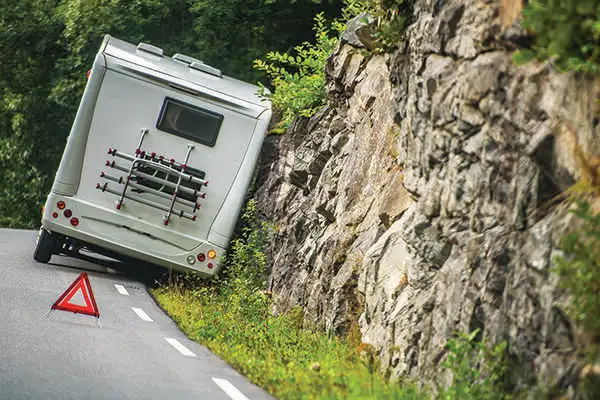For the longest time, the American Dream meant owning your own home, likely out in the suburbs. Your own little piece of American soil. Permanency. Dreams change.
For an increasing number of Americans, the dream nowadays isn’t residential permanency but permanent RV living. It is, perhaps, a sign of post-millennial America. The country has changed. The economy has changed. Housing is so insanely priced in many markets that a lot of the middle class is stuck being renters. It also helps that the definition of “job” has changed as well, particularly in a post-pandemic world. Companies now allow employees to work from home or from wherever, while the rise of the gig economy and freelancing means that people can design an income stream without pursuing a traditional job track.
For many, that means living permanently in a recreational vehicle. The freedom of the open road. Alighting wherever you want—whether to work or to play.
The trend is still small, relatively speaking. The RV Industry Association estimates that roughly 1 million Americans live permanently in a recreational vehicle. A spit in the ocean of traditional homeowners, that’s still a numerically large amount of people who have adopted the permanent RV lifestyle. And it will grow. The industry association now expects 2021 RV sales will hit a record high. I’m betting a goodly number of those new buyers will be looking to live in their RV permanently.Roughly 1 million Americans live in an RV.When I read about this trend, however, I started thinking about it from a financial writer’s perspective. Does it really make sense financially? I am not going to address the psychological value of the idea because each of us places a different, personal worth on the various choices we make in life. And I fully realize that costs do not equate with happiness for someone who simply wants a mobile residence in which they can move about the country freely. I get that.
Nevertheless, costs are involved…. First and foremost: Purchase Price
Depending on your needs and tastes—and whether those needs imply a motorhome you drive or a travel trailer pulled behind your car—the cost of an RV made for comfortable, permanent living is $10,000 to more than $250,000.
If you have the cash, great. If not, you’ll need financing, just as you do when you buy a house. The difference is that interest rates on RVs tend to be higher than for houses. A 30-year, fixed-rate mortgage these days is 3% or less. Two-year to 20-year RV loans currently range between 4.2% and 8.8%
In practical terms that means a $200,000 house with a 3% mortgage over 30 years will cost $843 per month. For that same payment over 20 years, you could afford a roughly $100,000 RV at a 5.5% interest rate. A used, $25,000 RV paid for over 10 years at 5.5% would run about $270 per month.
Of course, the real pain comes in the end. After 30 years, the house is paid off and is a $362,000 asset. (assuming 2% annual inflation). After 20 years, a used RV is worth a fraction of its purchase price—if it’s even worth anything. Camper Report found in an analysis of 200 different RV types that the typical RV has already lost a quarter of its value within three years of its manufacture date. Used RVs depreciate less quickly, but they still depreciate.
Insurance. Just as you need to insure your house, you need to insure an RV, even if that’s just to protect you from total wealth destruction in the event you cause an accident in your RV that damages lives or property. Insurance rates are all over the map. They’re dependent on the type of RV you own, its value, your driving record, the state in which you are insuring it, etc. Generally speaking, you’re looking at annual premiums of just under $900 in North Carolina, to well over $4,000 in Michigan.
RV hookup/camping fees. For the most part, you’re going to have to pay nightly hookup or camping fees to park your RV somewhere. Again, the range of fees is broad and depends on whether you’re parking for one night or for a month. Generally speaking, though, you’re looking at a fee of $25 to $80 a night, or at minimum $750 a month. In many cases, that includes water, electricity, and WiFi, but not always. If your job depends on access to the internet, then count on paying for an unlimited cellular data plan and turning your phone into a WiFi hotspot. That’s $60 to $80 a month.
To be fair, you could just park your RV in a place that offers free camping. That includes Walmart parking lots, some casinos, and some truck stops. Frankly, though, I wouldn’t really look forward to waking up every morning to a Walmart or truck-stop parking lot. And it’s certainly not where I’d want to spend my day as a freelance worker.
Another option is to sign up to a website such as BoondockersWelcome.com, which for an annual subscription of $50 gives you access to a host of locations where people are willing to let you park an RV on their land for free, though you might have to pay a hookup charge for electricity. This is good for short-term stays of five nights or less in any 90-day period; it wouldn’t serve your needs if you want to settle for a longer.

Fuel and miscellaneous. Again, fuel costs will range greatly on how much you drive, how much gas costs in whatever state you happen to be in, and the size of the fuel tank you must fill. But unless you’re going to stay put most of the time, you’re looking at several hundred dollars per month.
Then there are miscellaneous costs you might end up paying, such as new tires, oil changes, maintenance, annual park passes (if you’re a National Parks kind of person), toll roads and bridges, propane to run heating and refrigeration when you’re not stationary and connected to a power hookup. If you choose a motorhome, will you also pull a small car as your “get around easy” vehicle when you’re parked for a while and you just get to scoot off to the supermarket or, maybe, a doctor’s office? That’s more fuel, insurance, and maintenance costs to bake into your cake.
Do you need a storage unit somewhere to house all your stuff that you cannot haul around with you in an RV?
All in, permanent RV living rings the cash register at generally $2,500 to about $3,000 month. Some people get by on $2,000. Others spend well over $3,000. And none of that includes food, hobbies, entertainment, health insurance premiums, or the sundry other discretionary costs of daily life.
Again, let me say that I understand the rationale for living permanently in an RV. There is a primal draw there that I sympathize with. The beach one month, the mountains the next. East Coast in the fall, West Coast in the summer. Azaleas in bloom in the spring in the South. I absolutely get it.
But let me throw this idea out there… Living permanently overseas.
If you’re considering ways to sharply reduce costs in retirement, or the run up to retirement (and that defines a lot of people looking at an RV lifestyle) I am not convinced that living permanently in an RV is a silver bullet.
Yes, it can be cheaper, no doubt. But it’s not that much cheaper. Moreover, there are factors that create too much financial uncertainty: fuel prices skyrocket, a road accident creates severe financial hardship, unexpected maintenance drains your bank account (imagine: flat tires, a timing belt snaps, pistons crack, a pothole destroys your U-joints).
Living abroad, however, is substantially cheaper. It’s just as freeing and equally adventuresome, as well.
I know people who, in their 40s, 50s, and 60s packed up their life and relocated to Portugal, Spain, France, Italy, Uruguay, Colombia, Panama, Costa Rica, Mexico, Thailand, Malaysia, Vietnam, the Philippines, and elsewhere because the cost of living is so sharply cheaper.
Rent is cheaper. Food is generally cheaper, particularly locally produced products. Entertainment is cheaper. And healthcare is cheaper—which is a big one, given the out-of-control, nonsensical costs of healthcare in America.
Here in the Czech Republic, where I live, I pay about $120 a month for full coverage at care levels no different than when I lived in U.S. Better still, no co-pays, no deductibles, no ridiculous out-of-network surcharges. I’ve met retirees in Uruguay—including diabetics—who are paying under $100 month for healthcare and are quite happy with the level of care they receive. In Portugal, one of the highest-rated healthcare systems in the world (substantially higher than the U.S.), private health insurance is routinely less than $50 a month.You don’t realize how expensive the U.S. is.I can tell you from personal experience that you don’t realize just how expensive the U.S. is until you are paying for your life somewhere else. I mentioned the health costs (which alone save me about $400 a month), but I don’t pay any gas, auto insurance, or maintenance costs because where I live has such robust and efficient mass transit. That’s easily $500 to $1,000 a month in savings.
All of the savings that come from living permanently overseas mean either a higher standard of living on the money that you do have, or the capacity to save more money for retirement if, like me, you’re still in your asset-accumulation years.
I’m not saying living permanently in an RV is a bad thing. I’m just saying that there might be a better option.

Jeff D. Opdyke is the editor of The Global Intelligence Letter, IL’s guide to a richer, more rewarding life. Based in Prague, he spent 17 years at The Wall Street Journal and writes on personal finance and investment. Check out his free e-letter, Field Notes at IntLiving.com/FieldNotes
